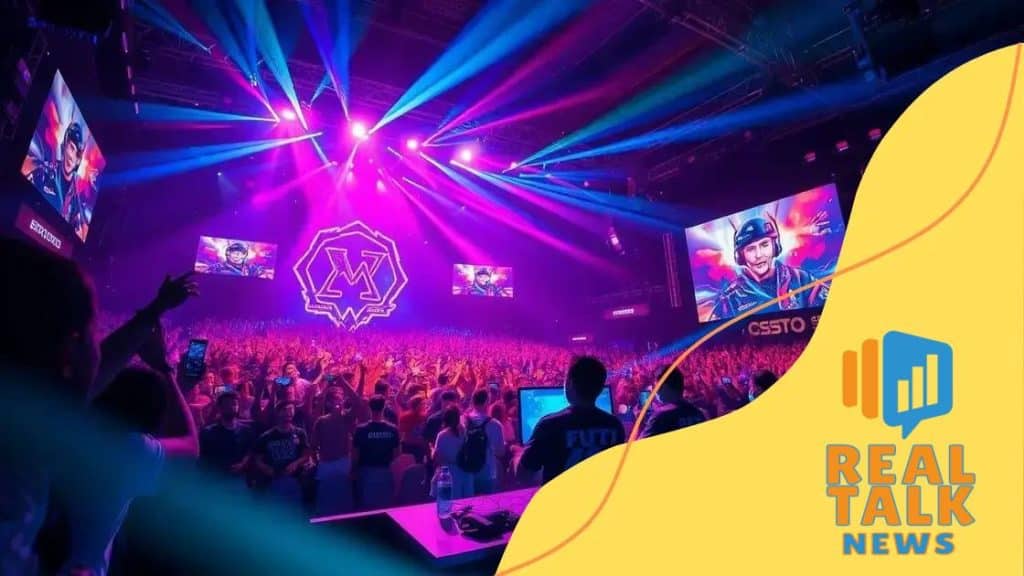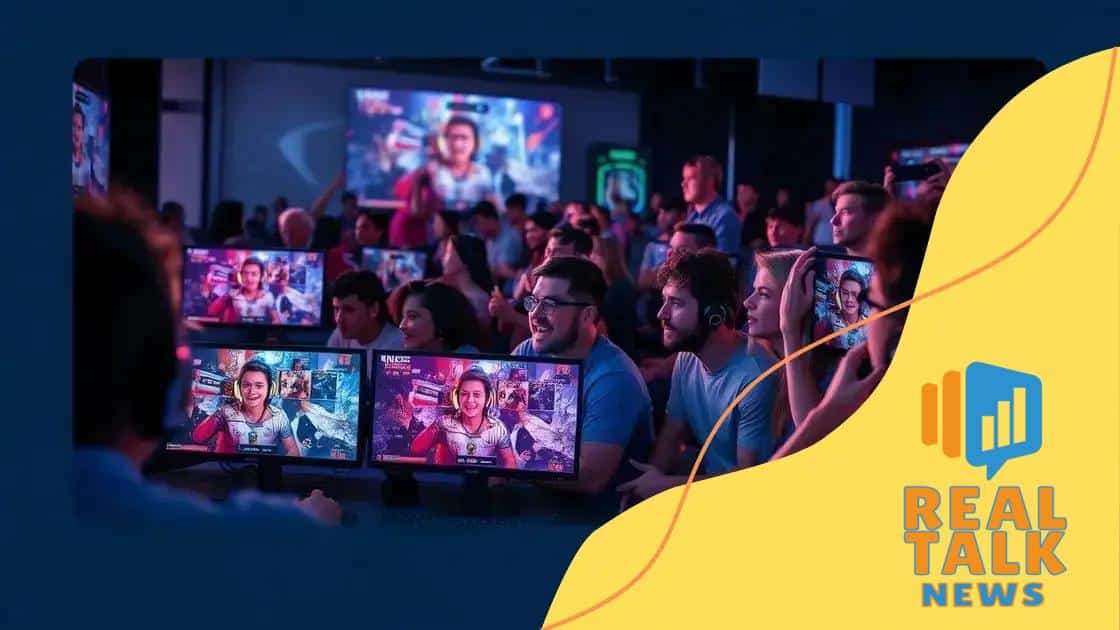How e-sports are influencing mainstream media content

How e-sports are influencing mainstream media content includes increasing viewer engagement through interactivity, brand sponsorships adapting to the gaming culture, and the rise of influencers shaping audience experiences.
How e-sports are influencing mainstream media content is a fascinating topic as they reshape our viewing habits and engagement strategies. Have you noticed how gaming is becoming part of the conversation in mainstream media? Let’s dive into this shift.
The rise of e-sports in popular culture
The rise of e-sports in popular culture has transformed the gaming landscape dramatically. Today, gaming is more than just a hobby; it’s a global phenomenon influencing many aspects of our lives. You might notice that e-sports events draw massive audiences, sometimes rivaling traditional sports in viewership.
Expansion into the Mainstream
As e-sports gain traction, they are becoming embedded in the fabric of popular culture. Major networks are now broadcasting e-sports events, showcasing talented players and thrilling competitions. This exposure repeats patterns that we’ve seen with traditional sports.
- Television commercials feature gamers
- Famous athletes endorse e-sports
- Colleges offer scholarships for gamers
This change signifies a shift not only in entertainment but also in how we perceive gaming. Once seen as an isolating activity, gaming now fosters community, bringing fans together to celebrate their favorite games and players.
Impact on Social Interaction
As gaming evolves, so does social interaction among fans. Platforms like Twitch and YouTube allow gamers to connect in real-time. This creates a unique environment where fans can engage with their favorite players directly. Regardless of age, fans are experiencing a sense of belonging.
- Live chat features enhance viewer engagement
- Communities form around specific games
- Holistic experiences through player partnerships
Moreover, events like the League of Legends World Championship illustrate how e-sports have captivated audiences. Attendees and viewers alike share the thrill, making it a cultural spectacle that unites millions.
The rise of e-sports signals a new era in entertainment where gaming is recognized as a legitimate form of competition and artistry. This shift opens the door for more diverse content and connects people from all walks of life.
How traditional media is adapting to e-sports
Traditional media is experiencing a significant shift as it adapts to the growing influence of e-sports. Networks are recognizing the potential of e-sports to attract younger audiences, redefining how content is delivered and consumed. This adaptation is essential for staying relevant in an ever-changing media landscape.
Integrating E-sports into Programming
Many networks have begun to incorporate e-sports into their regular programming. This includes airing live tournaments and producing dedicated e-sports shows. By doing this, traditional media outlets can engage viewers who might not be interested in conventional sports. The synergy between e-sports and mainstream media brings new life to stale programming.
- Live broadcasts of tournaments attract large viewerships.
- Analysis and commentary segments enhance viewer experience.
- Documentaries on top players improve audience connection.
As networks embrace these changes, they find that covering e-sports can lead to increased ratings. This shift encourages a collaboration between traditional media and the gaming community, fostering a larger cultural exchange.
Partnerships with Game Developers
Another key adaptation involves forming partnerships with game developers. Networks collaborate with developers to create content that showcases their games. This can include promotional events or exclusive broadcasts. Such partnerships benefit both industries, as they enhance brand visibility and expand fan engagement.
- Co-branded events draw audiences from both communities.
- Promotional content can boost game sales.
- Access to exclusive content attracts dedicated fans.
As traditional media continues to evolve, the blending of e-sports into their formats demonstrates a recognition of changing audience preferences. The integration of e-sports into mainstream content is not just a trend; it’s a permanent shift in how we consume entertainment.
The impact of e-sports on audience engagement

The impact of e-sports on audience engagement is profound and transformative. As gaming continues to rise in popularity, fans are engaging in ways that traditional sports have yet to match. Viewers are not just passive observers; they actively participate and interact.
Interactive Viewing Experiences
One significant way e-sports engages audiences is through interactive platforms. Fans can chat, vote, and influence outcomes during live tournaments. This level of interactivity creates a sense of community, as viewers feel connected to players and fellow fans.
- Live chats allow real-time discussion of game strategies.
- Polls let fans predict outcomes and vote on favorite players.
- Integrated social media feeds enhance live experiences.
As a result, the experience becomes more immersive, changing how people consume entertainment. Each match creates an atmosphere similar to a live sporting event, filled with cheers and community bonding.
Building Loyalty and Fandom
E-sports also plays a crucial role in building loyalty among fans. Gamers often follow players or teams closely, engaging with their content across multiple platforms. This strong connection fosters fandom, where viewers feel invested in the team’s success.
- Exclusive content from players deepens fan engagement.
- Fan merchandise helps solidify loyalty.
- Meet-and-greet opportunities create lasting memories.
Notably, platforms like Twitch provide content creators an avenue to showcase their personalities, further enhancing audience engagement. It’s not just about the game; it’s about the player’s story and how they connect with fans.
The impact of e-sports on audience engagement goes beyond viewership metrics. It reshapes how communities interact, creating fans who are more active and involved in the gaming culture. This shift is revolutionizing entertainment, proving that e-sports is here to stay.
Sponsorships and advertising: e-sports vs. traditional media
Sponsorships and advertising play a crucial role in the success of both e-sports and traditional media. While both are effective in reaching audiences, the methods and impacts differ significantly. Understanding these differences can provide insight into the evolving landscape of entertainment.
Brand Partnerships in E-sports
E-sports sponsorships often focus on direct engagement with fans. Brands are increasingly looking to connect with younger audiences who are avid gamers. Companies in technology, energy drinks, and apparel are leading the charge, investing heavily in e-sports teams and events.
- Targeting specific demographics helps brands connect.
- Live events provide an unparalleled exposure opportunity.
- Interactive advertisements create memorable experiences.
This kind of marketing is not just about promoting a product; it’s about building a lifestyle around gaming culture. By associating with e-sports, brands enhance their visibility and strengthen their relationships with consumers.
Advertising in Traditional Media
In contrast, traditional media relies on well-established advertising strategies. This includes commercial breaks during live sports events and sponsorships that reach broader, more diverse audiences.
- High production quality attracts viewer attention.
- Established metrics provide clear data on audience reach.
- Creative storytelling creates emotional connections.
While advertising in traditional media is often more about brand recognition, it lacks the interactive component that e-sports sponsorships offer. Traditional media advertisements can reach a large audience, but the engagement level is typically lower.
As both industries grow, they are finding new ways to collaborate and innovate. The rise of e-sports has forced traditional media to adapt, pushing them to rethink their strategies and appeal to the younger generation. This crossover can lead to exciting opportunities for both sectors, blending the best of sponsorship practices.
Future trends: e-sports and digital content creation
The future trends in e-sports and digital content creation promise exciting changes. As technology advances, both fields are evolving rapidly, allowing for innovative ways to engage audiences. Understanding these trends can help fans and creators stay ahead in this dynamic landscape.
Emerging Technologies
One key trend is the use of emerging technologies like virtual reality (VR) and augmented reality (AR) in e-sports. These technologies provide immersive experiences that can captivate audiences. Fans will soon be able to participate in the games like never before, feeling as if they are part of the action.
- VR tournaments offer a truly interactive experience.
- AR can enhance live events with engaging visuals.
- Gamers can train in simulated environments using these technologies.
This shift creates new opportunities for content creators to develop unique and engaging formats that attract viewers.
Influencer and Streamer Impact
Another trend is the growing influence of content creators and streamers in the e-sports community. These individuals often create entertaining and informative content that showcases their gaming skills. As their audiences grow, brands are keen to partner with these influencers for marketing campaigns.
- Streamers provide authentic interactions with fans.
- Influencer partnerships can drive product sales.
- Unique content styles can inspire new gaming trends.
As platforms evolve, content creators will continue to push the boundaries of what is possible in e-sports, making it more accessible and engaging for everyone.
The rise of e-sports and digital content will also lead to more collaboration between creators, brands, and developers. This synergy can result in fresh marketing strategies and engaging campaigns that resonate with audiences. Moreover, as competitions grow in popularity, content production will streamline, making it easier for fans to follow their favorite games and players.
Overall, the future of e-sports is bright. Emerging technologies and influencer engagement will shape a new era of entertainment that combines gaming with innovative storytelling.
The world of e-sports is changing rapidly, and its influence on mainstream media cannot be overstated. As technology continues to evolve, gamers and fans alike are seeing exciting new opportunities for engagement. Traditional media is adapting to this new landscape, finding ways to integrate e-sports into their programming and capitalize on the growing popularity of gaming. Sponsorships and marketing strategies are evolving, as brands recognize the power of reaching young audiences through this vibrant community. Looking to the future, the integration of emerging technologies and the rise of influencers will revolutionize how we experience entertainment. The combination of e-sports and digital content creation will continue to shape our world, making it more interactive and engaging than ever. Watching these changes unfold is sure to be an exhilarating journey for everyone involved.
FAQ – Frequently Asked Questions about E-sports and Media
How are e-sports changing the way we consume media?
E-sports are creating more interactive and engaging viewing experiences, allowing fans to participate actively rather than just watching passively.
What role do sponsorships play in e-sports?
Sponsorships are crucial for funding e-sports events and teams, allowing brands to connect with young audiences effectively.
How do influencers impact the e-sports industry?
Influencers and content creators have become key figures in e-sports, driving engagement and spreading awareness through their platforms.
What are some future trends in e-sports?
Future trends include the use of VR and AR technologies, increased collaboration between brands and e-sports organizations, and the rise of interactive content.





